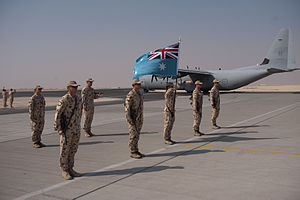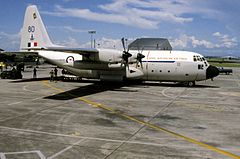- No. 37 Squadron RAAF
-
No. 37 Squadron RAAF 
No. 37 Squadron C-130J Hercules and personnel in the Middle East during 2009Active July 1943 – February 1948
February 1966 –Branch Royal Australian Air Force Role Air transport Part of No. 84 Wing Garrison/HQ RAAF Base Richmond Motto Foremost Engagements World War II
Vietnam War
Gulf WarAircraft flown Transport C-60 Lodestar (1943–45)
C-47 Dakota (1945–48)
C-130E Hercules (1966–99)
C-130H Hercules (1999–)
C-130J Hercules (2006–)No. 37 Squadron is a Royal Australian Air Force (RAAF) transport squadron. Formed in July 1943 at RAAF Station Laverton, Victoria, it currently operates C-130H and C-130J Hercules aircraft from RAAF Base Richmond, New South Wales. The unit saw active service flying C-60 Lodestars and C-47 Dakotas in World War II, before being disbanded in 1948. It reformed at Richmond in 1966 with C-130E Hercules, and operated flights between Australia and South-East Asia during the Vietnam War. The squadron has since been heavily involved in disaster relief in Australia and the region, as well as peacekeeping missions in the Pacific and the Middle East. Its motto is "Foremost".[1]
History
 Lockheed Lodestar No. 37 Squadron at Merauke, Dutch New Guinea, December 1944
Lockheed Lodestar No. 37 Squadron at Merauke, Dutch New Guinea, December 1944
No. 37 Squadron was established in July 1943 at RAAF Station Laverton, Victoria. It was first equipped with twin-engined Lockheed C-60 Lodestar transports and operated out of Parafield, South Australia, and Morotai in the Dutch East Indies. Towards the end of World War II, it re-equipped with Douglas C-47 Dakota twin-engined transports.[2][3] By May 1945, No. 37 Squadron was based in Essendon, Victoria. Following the end of hostilities, it was engaged in transporting former prisoners of war from Singapore to Australia, and later in conveying equipment to Japan for the British Commonwealth Occupation Force.[1][2] In August 1946, it joined Nos. 36 and 38 Squadrons, also flying Dakotas, as units of No. 86 Wing at RAAF Station Schofields, New South Wales. In February 1948, No. 37 Squadron was disbanded at Schofields.[2]
No. 37 Squadron reformed at RAAF Base Richmond, New South Wales, in February 1966.[4] Equipped with Lockheed C-130E Hercules, it began long-range missions in support of Australian forces in Vietnam including aero-medical evacuations conveying wounded soldiers back to Australia, generally via RAAF Base Butterworth, Malaysia.[5] On 5 February 1967, one of the unit's Hercules was the first Australian strategic transport aircraft to land at Vung Tau. The squadron also transported forces out of Vietnam following the Australian withdrawal from the conflict in December 1972.[6] As well as participating in military exercises and overseas peacekeeping commitments, the Hercules became well known in the Southern Pacific after being called on for relief following many natural disasters including tidal waves in New Guinea, cyclones in the Solomons and Tonga, and fires and floods throughout Australia.[7] It played a vital part in the evacuation of civilians following Cyclone Tracy in Darwin, Northern Territory, in 1974–75; a No. 37 Squadron C-130E was the first aircraft to touch down in Darwn following the disaster.[5] The Hercules also evacuated Australian embassy personnel from Saigon, South Vietnam, and Phnom Penh, Cambodia, following the end of the Vietnam War in 1975.[5][8] In January–February 1979, two No. 37 Squadron C-130Es evacuated Australian and other foreign embassy staff from Tehran, shortly before the collapse of royal rule during the Iranian Revolution.[9] In 1980, the squadron began operations with two ex-Qantas Boeing 707s, but handed them over to No. 33 Flight at the beginning of 1981.[10]
C-130E Hercules of No. 37 Squadron at Clark Air Base, Philippines, November 1981
In 1986, No. 37 Squadron transported the Popemobiles on John Paul II's tour of Australia; its other unusual cargoes have included kangaroos and sheep to Malaysia, and archaeological exhibits from China.[5] In February 1987, the unit again joined No. 36 Squadron, along with No. 33 Squadron, as part of a reformed No. 86 Wing under the newly established Air Lift Group.[11] The following year, No. 37 Squadron achieved 200,000 accident-free flying hours on the Hercules.[5] The Australian public had the experience of flying in the C-130s when they were employed by the Federal Government to provide air transport during the 1989 Australian pilots' dispute that curtailed operations by the two domestic airlines.[12]
Described as one of the "busiest" and "hardest-working" units in the RAAF, No. 37 Squadron re-equipped with new-model C-130J Hercules in 1999.[1] The unit has continued to support Australian peacekeeping missions around the world, including transport operations during the first Gulf War in 1990–91, and following the 2003 invasion of Iraq.[6][12][13] It was strengthened to create a "super squadron" on 17 November 2006, when its force of twelve C-130Js was augmented by twelve C-130Hs from No. 36 Squadron, prior to the latter re-equipping with the Boeing C-17 Globemasters and relocating to RAAF Base Amberley, Queensland.[6][14] In July 2008, No. 37 Squadron celebrated the 65th anniversary of its establishment during World War II.[13] It was transferred from No. 86 Wing to No. 84 Wing on 1 October 2010, as part of a restructure of Air Lift Group.[15]
Notes
- ^ a b c 37 Squadron at RAAF Museum. Retrieved on 26 December 2010.
- ^ a b c Roylance, Air Base Richmond, p. 92
- ^ Odgers, Air War Against Japan, p. 381
- ^ Roylance, Air Base Richmond, pp. , 117
- ^ a b c d e Roylance, Air Base Richmond, pp. 100–103
- ^ a b c Hamilton, FLGOFF Eamon (30 November 2006). "Dawn of a new era". Air Force News, Volume 48, No. 22. http://www.defence.gov.au/news/raafnews/editions/4822/topstories/story01.htm.
- ^ Stephens, The Royal Australian Air Force, p. 311
- ^ Stephens, The Royal Australian Air Force, p. 274
- ^ "RAAF Evacuation of Australians from Iran, 1979". Pathfinder, Issue 64. April 2007. http://airpower.airforce.gov.au/Publications/List/41/Pathfinder.aspx?page=5.
- ^ Boeing 707 at RAAF Museum. Retrieved on 24 February 2011.
- ^ Roylance, Air Base Richmond, pp. 107–108, 116–117
- ^ a b Roylance, Air Base Richmond, pp. 110–111
- ^ a b "Heavy Workload for Hercules as 37 Squadron Marks 65th Anniversary". Department of Defence. 17 July 2008. http://www.defence.gov.au/media/DepartmentalTpl.cfm?CurrentId=7992. Retrieved 26 December 2010.
- ^ "Royal Australian Air Force Squadrons Celebrate New Role". Department of Defence. 17 November 2006. http://www.defence.gov.au/media/DepartmentalTpl.cfm?CurrentId=6145. Retrieved 30 November 2010.
- ^ "Restructure of Air Lift Group Units". Department of Defence. 5 October 2010. http://www.defence.gov.au/media/download/2010/Oct/20101005c/index.htm. Retrieved 6 October 2010.
References
- Odgers, George (1968) [1957]. Australia in the War of 1939–1945: Series Three (Air) Volume II – Air War Against Japan 1943–45. Canberra: Australian War Memorial. http://www.awm.gov.au/histories/second_world_war/volume.asp?levelID=67913.
- Roylance, Derek (1991). Air Base Richmond. RAAF Base Richmond: Royal Australian Air Force. ISBN 0-646-05212-8.
- Stephens, Alan (2006) [2001]. The Royal Australian Air Force: A History. Melbourne: Oxford University Press. ISBN 0-19-555541-4.
Main series 1 · 2 · 3 · 4 · 5 · 6 · 7 · 8 · 9 · 10 · 11 · 12 · 13 · 14 · 15 · 20 · 21 · 22 · 23 · 24 · 25 · 26 · 27 · 28 · 29 · 30 · 31 · 32 · 33 · 34 · 35 · 36 · 37 · 38 · 40 · 41 · 42 · 43 · 60 · 66 · 67 · 71 · 73 · 75 · 76 · 77 · 78 · 79 · 80 · 82 · 83 · 84 · 85 · 86 · 87 · 92 · 93 · 94 · 99 · 100 · 102 · 107 · 292 · Fighter · Rescue and Communication · Seaplane · Berlin Air Lift
Article XV squadrons Joint Netherlands-Australian squadrons Categories:- RAAF squadrons
- Military units and formations established in 1943
Wikimedia Foundation. 2010.

